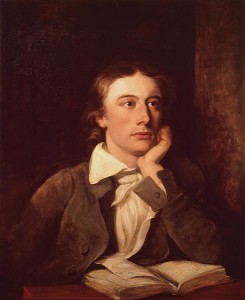Our final poetry news of the week take a look at the CGI project that has brought Keats back from the dead.
Bringing Keats Back from the Dead
 The poet John Keats might have been dead for 200 years, but now thanks to some superb advances in science he is to be brought back to life, virtually. A group of scientists at the Institute for Digital Archaeology have been working with the latest advances in CGI on the project which is being run to mark the 200th anniversary of the poet’s death.
The poet John Keats might have been dead for 200 years, but now thanks to some superb advances in science he is to be brought back to life, virtually. A group of scientists at the Institute for Digital Archaeology have been working with the latest advances in CGI on the project which is being run to mark the 200th anniversary of the poet’s death.
Keats died on 23rd February in 1821 in Rome from Tuberculosis. The project is not only looking at recreating his voice but also his face and his clothing, and all in the setting of the room in Rome where he died.
The team is made up of scientists, animators, clothing experts, historians and linguistics experts. Once they have brought the poet to “life” they will create an interactive virtual reality version of Keats which will read one of his most famous poems in a live event that will take place on 23rd February. They are planning to give the poet what they are referring to as an “extra 24 hours of life”. This is a slight dig at the poet’s tombstone which indicates that he died a day later than records indicate.
Keats was just 25 years old when he died. At the suggestion of his doctors, he had moved to Rome where it was hoped that the Mediterranean climate would help to ease the symptoms of his tuberculosis. Whilst he was here, he wrote what is possibly his most famous poet “Bright Star”. It is this poem that the CGI version of the poet will be reciting in a virtual replica of the house that the poet shared with fellow poet Percy Bysshe Shelley.
It is hoped that with the help of pictures painted at the time and life and death masks of the poet, the visual Keats will be as historically accurate as possible. The masks of the poet have been used to make numerous scans which have then aided in the final virtual reconstruction of the poet’s face.
Clothing gave the project some issues. There is much anecdotal evidence that indicates that Keats in fact adopted a style of dress that was more “continental” during his time in Rome.
In order to assume the most accurate type of clothing for Keats, a clothing expert examined images of fellow poets Lord Byron and Shelley, who were with Keats in Italy and adopted the same style of clothing.
The voice proved however to be the most difficult part of the project as there is only written, anecdotal evidence to go on for this. The accounts the team found suggested that the poet would have been of the “cockney school” and would have made frequent use of inelegant rhymes in his speech. It is also believed he may have placed more emphasis on the final letter in many words, those ending with “t”. Experts also believe he would have placed greater diction on the pronunciation of the letter “l” unlike modern cockneys and that his accent might have been a little more mixed, including some west country intonations.


You must register to comment. Log in or Register.